Browse by Room

BATHROOM
Bathrooms have evolved from a simply utilitarian space into a private retreat for relaxation, escape and self-indulgence. The right lighting can make a bathroom even more inviting.
Whether built new or recently remodeled, bathrooms today demand intricate lighting solutions. Task lighting must be bright enough to do its job, but also work well with indirect accent lighting to soften the bathroom's ambiance. Decorative and ornate light fixtures and lamps provide elegance and sophistication. Shower lights brighten up enclosed stalls. Reading lamps by the toilet provide more focused light.
Whether built new or recently remodeled, bathrooms today demand intricate lighting solutions. Task lighting must be bright enough to do its job, but also work well with indirect accent lighting to soften the bathroom's ambiance. Decorative and ornate light fixtures and lamps provide elegance and sophistication. Shower lights brighten up enclosed stalls. Reading lamps by the toilet provide more focused light.
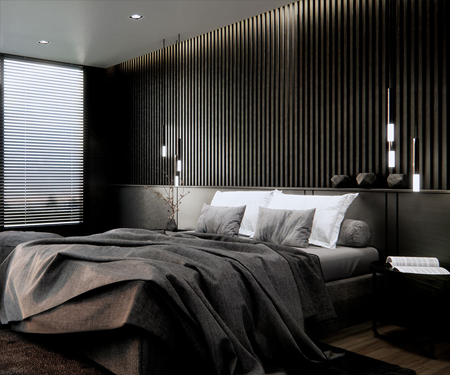
BEDROOM
When lighting a bedroom, it is important to create an overall atmosphere of quiet relaxation, while providing some bright lighting areas for reading and other activities. A combination of general and task lighting that takes into account the age and lifestyle of the occupants is also important. Adding dimming controls will give you flexibility to vary the bedroom lighting to suit different moods and activities.
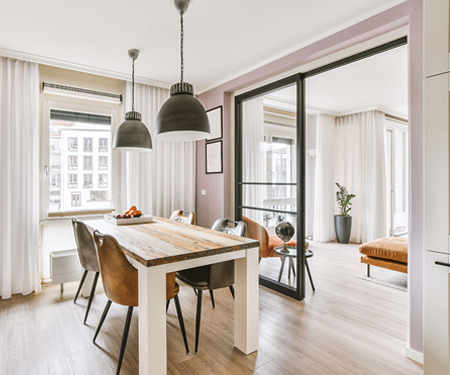
DINING ROOM
Dining room lighting should be both beautiful and functional. This is best accomplished by using a combination of task, ambient and accent lighting. These various layers of lighting establish the mood for a variety of functions, including dining, homework or family bookkeeping. Dimming controls will enable you to vary the light for each function.
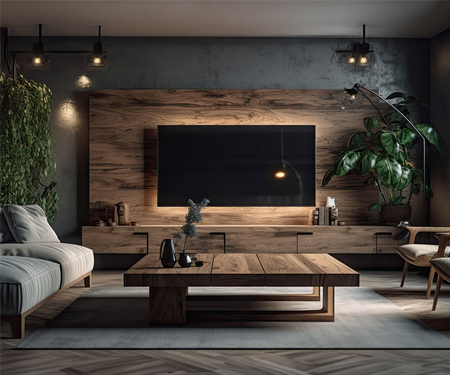
FAMILY / GREAT ROOM
Whether you use these rooms for entertaining, watching television, reading, or playing games, three to four layers of lighting should be used. These might include recessed lighting at the perimeter of the room, a chandelier or central decorative fixture for general lighting, wall sconces for mood and lamps for reading and other tasks. Use dimmers whenever possible for maximum control of all fixtures.
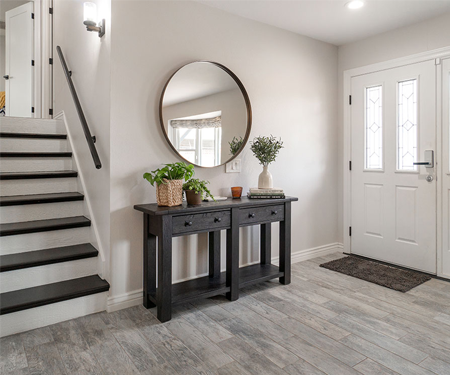
ENTRY / FOYER
In the entrance foyer, general lighting is needed to welcome guests and provide safety. This can be furnished by a decorative ceiling fixture, such as a large pendant light, that emits a generous spread of light. If more light is needed, consider placing matching wall sconces on either side of a foyer mirror.
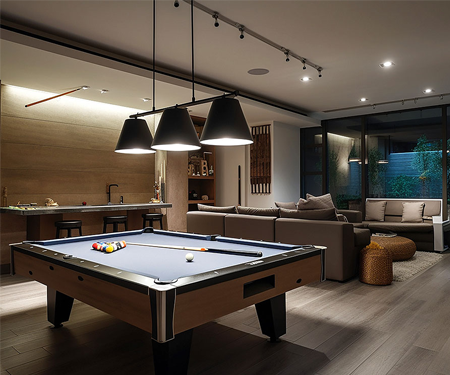
GAME ROOM
Proper lighting in a home theater or game room area requires a mix of ambient and accent lighting to enhance your viewing, prevent eyestrain and make the room practical to move around in after the movie or for other activities.
For general lighting, recessed light fixtures operating via a dimmer provide soft ambient lighting that will let you see your snacks without distracting from the movie. Another option is to install wall sconces or track lighting to provide a glow along the home theater room's walls.
For general lighting, recessed light fixtures operating via a dimmer provide soft ambient lighting that will let you see your snacks without distracting from the movie. Another option is to install wall sconces or track lighting to provide a glow along the home theater room's walls.

HALLWAY
For safety, hallways should be illuminated every 8 to 10 feet. You can do this with flush-mount ceiling fixtures, wall sconces, recessed fixtures or track lighting. Movable track fixtures can provide the general lighting you need for safety, while allowing you to accent any artwork or family photos to steer the eye.
Stairs should be lighted from top to bottom to prevent accidents, with switches at both ends for convenience. If hall and foyer lighting fixtures do not illuminate the entire stairway, you may consider adding a chain-hung or close-to-ceiling fixture above the stairs.
Stairs should be lighted from top to bottom to prevent accidents, with switches at both ends for convenience. If hall and foyer lighting fixtures do not illuminate the entire stairway, you may consider adding a chain-hung or close-to-ceiling fixture above the stairs.

KITCHEN
In today's world, the kitchen is often the center of family activity. Kitchen Lighting requirements depend on the size and complexity of the kitchen space. While the kitchen is primarily a work area, it may also be used for dining or as a gathering place for family and friends. Small kitchens may require only a central ceiling fixture and task lighting tucked under a cabinet. More elaborate kitchens will demand a blend of general, task and accent lighting.
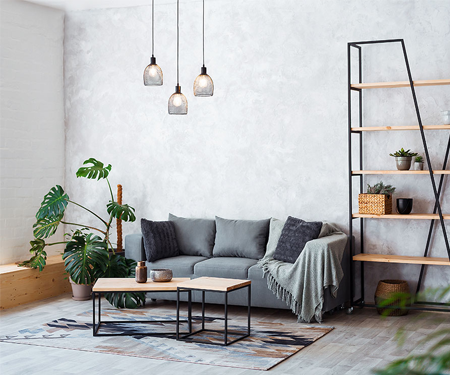
LIVING ROOM
The living room is the most important room in the house because it's usually the place the family spends the most time. There are many different uses for the room, so it's important to make sure you have the appropriate lighting.
There's actually a proven formula for calculating the proper amount of general light (usually expressed as the number of watts) you should have in each room or area of your home . . . and it's not difficult, just some basic arithmetic.
Multiply the length times the width of the room. Then, multiply that number times 1.5. That gives you the amount of wattage you need to light the room properly for general illumination. Example: A room is 12 ft. x 16 ft. (12 x 16 = 192). Then multiply 192 x 1.5 = 288 watts. That means an 8-light chandelier using 40-watt bulbs would give 320 watts, which is even more light than needed.
For specific task lighting in areas where stronger light is needed, multiply the area's square footage by 2.5 rather than 1.5 to find the needed wattage. A kitchen work island or a desk area where schoolwork is done are examples of task areas in your home. Instructions provided by Kichler Lighting.
There's actually a proven formula for calculating the proper amount of general light (usually expressed as the number of watts) you should have in each room or area of your home . . . and it's not difficult, just some basic arithmetic.
Multiply the length times the width of the room. Then, multiply that number times 1.5. That gives you the amount of wattage you need to light the room properly for general illumination. Example: A room is 12 ft. x 16 ft. (12 x 16 = 192). Then multiply 192 x 1.5 = 288 watts. That means an 8-light chandelier using 40-watt bulbs would give 320 watts, which is even more light than needed.
For specific task lighting in areas where stronger light is needed, multiply the area's square footage by 2.5 rather than 1.5 to find the needed wattage. A kitchen work island or a desk area where schoolwork is done are examples of task areas in your home. Instructions provided by Kichler Lighting.

OFFICE / DEN
Whether you work full time out of your home office or just use it as a space to pay the bills, surf the web, or as a quiet space for the kids to do their homework, a well lit workspace is essential to reduce glare and make your tasks easier. Floor and table lamps work well in these areas as they are highly configurable to your furniture arrangement as these rooms tend to be re-configured frequently.
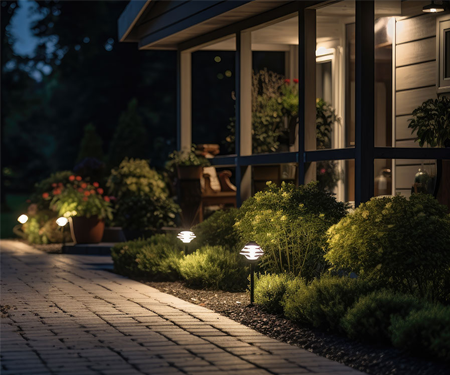
OUTDOOR / PATIO
Outdoor lighting greatly enhances the curb appeal of your property while providing safety and security. Outdoor lighting also allows you to take advantage of your outdoor spaces after dark and adds value to your home.